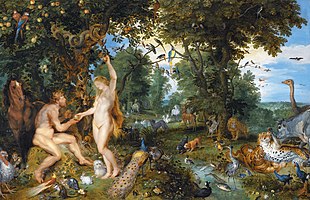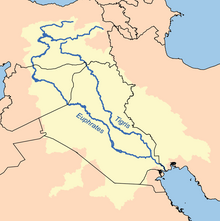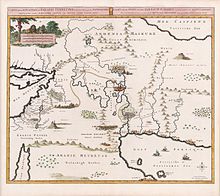Garden of Eden

| Part of a series on |
| Utopias |
|---|
| Mythical |
| Theoretical |
|
| Movements |
| Reality related to utopia |
The Garden of Eden (Hebrew: גַּן־עֵדֶן – gan-ʿḖḏen) or Garden of God (Hebrew: גַן־יְהוָה – gan-Yhwh), also called the Terrestrial Paradise, is the biblical paradise described in Genesis 2-3 and Ezekiel 28 and 31.[1][2] Comparisons to Eden are also made in the Bible in Genesis,[3] Isaiah 51:3,[4] Ezekiel 36:35,[5] and Joel 2:3;[6] Zechariah 14 and Ezekiel 47 use paradisical imagery without naming Eden.[7]
The name derives from the Akkadian edinnu, from a Sumerian word edin meaning "plain" or "steppe", closely related to an Aramaic root word meaning "fruitful, well-watered".[2] Another interpretation associates the name with a Hebrew word for "pleasure"; thus the Vulgate reads "paradisum voluptatis" in Genesis 2:8 and Douay–Rheims, following, has the wording "And the Lord God had planted a paradise of pleasure".[8]
The location of Eden is described in the Book of Genesis as the source of four tributaries. Among scholars who consider it to have been real, there have been various suggestions for its location:[9] at the head of the Persian Gulf, in southern Mesopotamia (now Iraq) where the Tigris and Euphrates rivers run into the sea;[10] and in Armenia.[11][12][13]
Like the Genesis flood narrative, the Genesis creation narrative and the account of the Tower of Babel, the story of Eden echoes the Mesopotamian myth of a king, as a primordial man, who is placed in a divine garden to guard the tree of life.[14] The Hebrew Bible depicts Adam and Eve as walking around the Garden of Eden naked due to their sinlessness.[15]
Biblical narratives[]
Genesis[]


The second part of the Genesis creation narrative, Genesis 2:4–3:24, opens with YHWH-Elohim (translated here "the LORD God", see Names of God in Judaism) creating the first man (Adam), whom he placed in a garden that he planted "eastward in Eden".[16] "And out of the ground made the Lord God to grow every tree that is pleasant to the sight, and good for food; the tree of life also in the midst of the garden, and the tree of knowledge of good and evil."[17]
The man was free to eat from any tree in the garden except the tree of the knowledge of good and evil. Last of all, God made a woman (Eve) from a rib of the man to be a companion for the man. In chapter three, the man and the woman were seduced by the serpent into eating the forbidden fruit, and they were expelled from the garden to prevent them from eating of the tree of life, and thus living forever. Cherubim were placed east of the garden, "and a flaming sword which turned every way, to guard the way of the tree of life".[18]
Genesis 2:10-14[19] lists four rivers in association with the garden of Eden: Pishon, Gihon, Hiddekel (the Tigris), and Phirat (the Euphrates). It also refers to the land of Cush—translated/interpreted as Ethiopia, but thought by some to equate to Cossaea, a Greek name for the land of the Kassites.[20] These lands lie north of Elam, immediately to the east of ancient Babylon, which, unlike Ethiopia, does lie within the region being described.[21] In Antiquities of the Jews, the first-century Jewish historian Josephus identifies the Pishon as what "the Greeks called Ganges" and the Geon (Gehon) as the Nile.[22]
According to Lars-Ivar Ringbom the paradisus terrestris is located in Takab in northwestern Iran.[23]
Ezekiel[]
In Ezekiel 28:12-19[24] the prophet Ezekiel the "son of man" sets down God's word against the king of Tyre: the king was the "seal of perfection", adorned with precious stones from the day of his creation, placed by God in the garden of Eden on the holy mountain as a guardian cherub. But the king sinned through wickedness and violence, and so he was driven out of the garden and thrown to the earth, where now he is consumed by God's fire: "All those who knew you in the nations are appalled at you, you have come to a horrible end and will be no more." (v.19).
According to Terje Stordalen, the Eden in Ezekiel appears to be located in Lebanon.[25] "[I]t appears that the Lebanon is an alternative placement in Phoenician myth (as in Ez 28,13, III.48) of the Garden of Eden",[26] and there are connections between paradise, the Garden of Eden and the forests of Lebanon (possibly used symbolically) within prophetic writings.[27] Edward Lipinski and Peter Kyle McCarter have suggested that the garden of the gods, the oldest Sumerian analog of the Garden of Eden, relates to a mountain sanctuary in the Lebanon and Anti-Lebanon ranges.[28]
Proposed locations[]

The location of Eden is described in Genesis 2:10–14:[29]
And a river departed from Eden to water the garden, and from there it divided and became four tributaries.
The name of the first is Pishon, which is the circumnavigator of the land of Havilah where there is gold. And the gold of this land is good; there are bdellium and cornelian stone. And the name of the second river is Gihon, which is the circumnavigator of the land of Cush.
And the name of the third is Chidekel, which is that which goes to the east of Ashur; and the fourth river is Phirath.
Suggestions for the location of the Garden of Eden include[9] the head of the Persian Gulf, as argued by Juris Zarins, in southern Mesopotamia (now Iraq) where the Tigris and Euphrates rivers run into the sea;[10] and in the Armenian Highlands or Armenian Plateau.[11][30][12][13] British archaeologist David Rohl locates it in Iran, and in the vicinity of Tabriz, but this suggestion has not caught on with scholarly sources.[31]
On his third voyage to the Americas, in 1498, Christopher Columbus thought he may have reached the Earthly Paradise upon first seeing the South American mainland.[32]
Some religious groups have believed the location of the garden to be local to them, outside of the Middle East. Some early leaders of Mormonism held that it was located in Jackson County, Missouri.[33] The 20th-century Panacea Society believed it was located at the site of their home town of Bedford, England,[34] while preacher Elvy E. Callaway believed it was on the Apalachicola River in Florida, near the town of Bristol.[35]
Parallel concepts[]

- Dilmun in the Sumerian story of Enki and Ninhursag is a paradisaical abode[36] of the immortals, where sickness and death were unknown.[37]
- The garden of the Hesperides in Greek mythology was somewhat similar to the Jewish concept of the Garden of Eden, and by the 16th century a larger intellectual association was made in the Cranach painting. In this painting, only the action that takes place there identifies the setting as distinct from the Garden of the Hesperides, with its golden fruit.
- The word "paradise" entered English from the French paradis, inherited from the Latinparadisus, from Greek parádeisos (παράδεισος), from an Old Iranian form, from Proto-Iranian*parādaiĵah- "walled enclosure", whence Old Persian